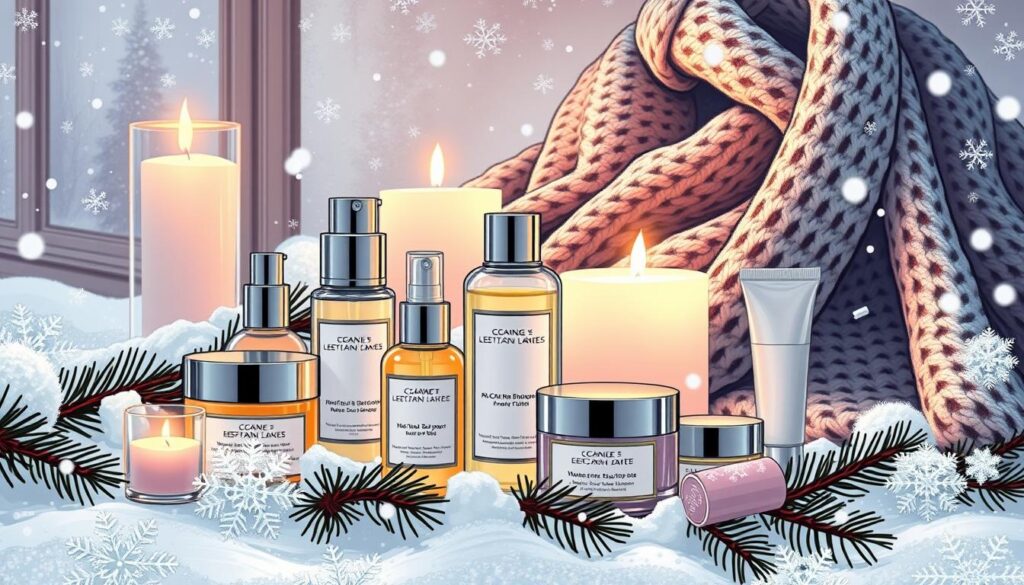10 Surprising Winter Skincare Mistakes You’re Probably Making
As the temperature drops and the air becomes drier, your skin faces a unique set of challenges during the winter months. In fact, a recent survey revealed that over 60% of people struggle with common winter skincare errors, leading to dry, irritated, and dull complexions. From neglecting moisturizer to over-exfoliating, these seemingly innocuous mistakes can have a significant impact on the health and appearance of your skin.
In this comprehensive guide, we’ll uncover 10 surprising winter skincare mistakes you might be making and provide practical solutions to help you achieve a glowing, radiant complexion all season long. Whether you have dry, oily, or combination skin, understanding the unique challenges of cold weather and adjusting your routine accordingly can make all the difference.
Key Takeaways
- Winter weather and indoor heating can take a toll on your skin, leading to dryness, irritation, and dullness.
- Common mistakes include skipping moisturizer, over-exfoliating, and forgetting sunscreen.
- Proper hydration, product selection, and adjusting your skincare routine are crucial for maintaining healthy, glowing skin in the colder months.
- Addressing specific skin type concerns and consulting a skincare specialist can help you achieve a customized winter skincare regimen.
- Staying informed about winter skincare myths and implementing a seasonal game plan can help you avoid common pitfalls and achieve radiant skin all winter long.
Understanding Winter Skin Challenges
As the cold weather sets in, your skin faces a unique set of challenges. The drop in temperature and low humidity levels can strip your skin of its natural moisture, leading to dryness, irritation, and even exacerbation of existing skin conditions. But that’s not all – the use of indoor heating further complicates matters by reducing the air humidity, creating a perfect storm for cold weather skincare woes.
Why Cold Weather Affects Your Skin
The colder air during the winter months contains less moisture, causing your skin to lose its hydration more quickly. This can lead to a disruption in your skin’s natural barrier, making it more susceptible to dry skin and irritation. Additionally, the constant exposure to the elements, such as wind and cold, can cause your skin to become red, flaky, and tight.
The Role of Indoor Heating
The use of indoor heating, whether it’s from a furnace, fireplace, or space heater, can further compound the problem. These heating sources actively reduce the air humidity, drawing moisture out of the air and your skin. This can result in an even more severe state of dryness, potentially leading to uncomfortable tightness, itchiness, and an overall lack of radiance.
Understanding these unique winter skin challenges is the first step towards developing an effective cold weather skincare routine that can help you maintain healthy, glowing skin throughout the colder months.
Common Skincare Mistakes to Avoid
Maintaining a healthy, glowing complexion during the winter months can be a challenge, but avoiding a few common skincare missteps can make a big difference. From skipping moisturizer to overusing exfoliators, these are the errors you’ll want to steer clear of for radiant skin all season long.
Skipping Moisturizer
One of the biggest moisturizer mistakes people make in the winter is neglecting to moisturize their skin. The cold, dry air can strip your complexion of its natural oils, leading to increased dryness and a compromised skin barrier. Make sure to apply a nourishing moisturizer morning and night to lock in hydration and prevent flakiness.
Overusing Exfoliators
While regular exfoliation errors can help slough off dead skin cells, over-exfoliating can be detrimental during the winter. Harsh scrubs and chemical peels can strip the skin of its natural oils, causing irritation and dryness. Stick to a gentle exfoliating routine, no more than 1-2 times a week, to maintain a healthy glow without compromising your skin’s moisture levels.
Neglecting Sunscreen
Many people make the mistake of thinking they don’t need sun protection oversight in the winter, but UV rays can still cause damage to the skin year-round. Make sunscreen application a non-negotiable part of your daily routine, even on cloudy days, to prevent premature aging and discoloration.
By steering clear of these common skincare pitfalls, you’ll be well on your way to achieving a luminous, healthy-looking complexion all season long.
Choosing the Right Products for Winter
As the temperatures drop and the air becomes drier, it’s crucial to adjust your skincare routine to accommodate the winter season. When it comes to choosing the right winter skincare products, look for formulations that prioritize hydration and gentle, nourishing ingredients.
Ingredients to Look For
During the colder months, your skin craves hydrating ingredients that can lock in moisture and prevent it from escaping. Look for products containing hyaluronic acid, ceramides, and glycerin, as these ingredients are known for their ability to deeply hydrate and strengthen the skin’s barrier.
Opt for creamy, oil-based moisturizers rather than water-based ones, as they tend to be more nourishing and occlusive, helping to seal in hydration.
Avoiding Harsh Chemicals
While it may be tempting to use products with stronger active ingredients in an effort to combat dryness, it’s crucial to avoid harsh chemicals that can further irritate and compromise the skin. Steer clear of products containing alcohol, fragrances, and other potential irritants, as they can strip the skin of its natural oils.
Consider incorporating facial oils and serums with nourishing ingredients like vitamin E and niacinamide, which can help to soothe and replenish the skin. Additionally, choose gentle, non-foaming cleansers to prevent stripping the skin of its natural protective barrier.

By prioritizing hydrating ingredients and avoiding harsh formulations, you can ensure that your skin stays healthy, plump, and radiant throughout the winter months.
Hydration: The Key to Radiant Winter Skin
During the winter months, when the air is dry and cold, maintaining adequate hydration becomes crucial for healthy, glowing skin. Proper hydration not only nourishes the skin but also helps it retain its youthful, radiant appearance.
Drinking Enough Water
Increasing your water intake is a simple yet effective way to keep your skin hydrated. Aim for at least 8 glasses of water per day, and consider incorporating hydrating foods like cucumbers, watermelon, and herbal teas into your diet. Staying hydrated from the inside out can help combat the drying effects of winter weather.
Humidifiers—A Skin-Saving Tool
Using a humidifier in your home or office can make a significant difference in your skin’s hydration levels. Humidifiers add moisture to the air, counteracting the drying effects of indoor heating. Be sure to place humidifiers in key areas, such as your bedroom and workspace, to maintain a comfortable level of humidity throughout the day.
| Humidifier Brands | Moisture Output | Coverage Area | Price Range |
|---|---|---|---|
| Levoit | Up to 500 mL/day | Up to 400 sq. ft. | $50 – $100 |
| Honeywell | Up to 800 mL/day | Up to 700 sq. ft. | $80 – $150 |
| Vicks | Up to 1 gallon/day | Up to 1000 sq. ft. | $40 – $90 |
By incorporating these hydration strategies into your winter skincare routine, you can help your skin maintain its radiance and resilience throughout the colder months.
Adjusting Your Skincare Routine
As the winter chill sets in, it’s essential to adapt your skincare routine to address the unique challenges this season brings. Your morning and evening regimens should work in harmony to keep your skin nourished, protected, and radiant throughout the cooler months.
Morning vs. Evening Routines
During the morning, focus on building a protective barrier against the elements. Start with a gentle cleanser to remove any impurities, then follow up with a hydrating serum and a rich, creamy moisturizer. Don’t forget to apply a broad-spectrum sunscreen to shield your skin from the sun’s rays, even on overcast days.
In the evening, shift your focus to repair and replenishment. Remove your makeup and cleanse thoroughly to allow your skin to absorb the nourishing ingredients in your products. Consider incorporating a facial oil or serum to deliver an extra boost of hydration and nourishment. Finish with a moisturizer that suits your skin type, ensuring your complexion is well-equipped to recover and rejuvenate overnight.
When to Switch Products
As the temperature drops, it’s time to swap out your lightweight, summer-friendly products for their richer, more emollient counterparts. Look for moisturizers and serums that contain ingredients like hyaluronic acid, ceramides, and shea butter to lock in moisture and keep your skin supple. Adjust the application order of your products, applying thinner formulas before thicker ones, to maximize their effectiveness.
By tuning into your skin’s evolving needs and making strategic adjustments to your winter skincare routine, you can maintain a healthy, radiant complexion throughout the colder months. Embrace the seasonal skincare changes and enjoy the benefits of a customized approach to your skincare regimen.
The Importance of Lip Care
As the winter chill sets in, our lips often become the first victims of the harsh elements. Cracked, dry, and painfully chapped lips can be a common struggle during this season. However, with the right lip care routine, you can keep your pout healthy, hydrated, and protected all winter long.
Common Lip Care Errors
One of the biggest mistakes people make is licking their lips, which can actually exacerbate dryness and lead to further cracking. Additionally, neglecting to use a gentle lip scrub to remove dead skin cells can prevent your lip balm from effectively penetrating and nourishing the delicate skin.
Recommended Lip Products for Winter
- Look for lip balms and treatments that contain moisturizing ingredients like beeswax, shea butter, and vitamin E. These will help seal in hydration and protect your lips from the elements.
- Apply a lip balm with SPF during the day to shield your lips from damaging UV rays, which can contribute to dryness and peeling.
- Use a thicker, more occlusive lip product at night to intensely hydrate and repair your lips while you sleep.
- Reapply your lip balm or treatment frequently throughout the day to maintain a continuous barrier against the cold, dry air.
By addressing common lip care errors and incorporating the right products into your routine, you can keep your cracked lips, lip care, and winter lip protection in check all season long.

Debunking Winter Skincare Myths
As the temperature drops and the air becomes drier, many common winter skincare myths can lead to poor skin health. It’s time to separate fact from fiction and set the record straight on these misconceptions.
The Truth About Oily Skin
One persistent myth is that oily skin doesn’t need moisturizer in the winter. In reality, oily skin in winter still requires hydration to prevent the overproduction of sebum. Failing to moisturize can lead to a vicious cycle of more oil and clogged pores. The key is to choose a lightweight, oil-free moisturizer that won’t further clog the skin.
Moisturizing after Showering
Another myth is that skin is sufficiently hydrated after a hot shower. In fact, winter skincare experts recommend moisturizing immediately after bathing to lock in moisture. Hot water can strip the skin of its natural oils, leaving it dry and vulnerable.
By debunking these myths, you can optimize your winter skincare routine and keep your complexion glowing all season long.
Skin Types and Winter Care Tips
When it comes to winter skincare, understanding your unique skin type is crucial. Whether you have dry, oily, or a combination of both, customizing your routine can make all the difference in maintaining a healthy, radiant complexion during the colder months.
Dry Skin Strategies
For those with dry skin, the winter season can be especially challenging. The dry, frigid air and indoor heating can strip the skin of its natural oils, leading to tightness, flakiness, and an overall dull appearance. To combat this, opt for richer, oil-based moisturizers that can deeply nourish and replenish the skin. Gentle, creamy cleansers are also key to avoid stripping the skin further.
Oily Skin in Cold Weather
Surprisingly, those with oily skin may also struggle during the winter. The drop in temperature can cause the skin to produce even more oil in an attempt to compensate for the dryness. To manage this, look for lightweight, non-comedogenic (non-pore-clogging) hydrators and continue using salicylic acid-based products to control shine and prevent breakouts.
| Skin Type | Winter Skincare Concerns | Recommended Solutions |
|---|---|---|
| Dry Skin | Tightness, flakiness, dullness | Oil-based moisturizers, creamy cleansers |
| Oily Skin | Increased oil production, breakouts | Lightweight, non-comedogenic hydrators, salicylic acid products |
Regardless of your skin type, the key to achieving healthy, glowing skin this winter is to tailor your skincare routine to your specific needs. By addressing the unique challenges your skin faces, you can maintain a balanced, radiant complexion all season long.
Signs You’re Overdoing Your Skincare
As the temperature drops and the air becomes drier, it’s tempting to ramp up your skincare routine in pursuit of hydrated, glowing skin. However, too much of a good thing can actually do more harm than good. Recognizing the signs of skin irritation and finding the right balance in your winter skincare regimen is crucial.
How to Recognize Skin Irritation
Redness, flaking, increased sensitivity, and even breakouts can all be signs that you’re overdoing it with your skincare products. Paying close attention to how your skin feels after application is key. If you experience a tight, stinging, or burning sensation, it’s a clear indication that your skin is becoming irritated.
Striking the Right Balance
Overexfoliation is a common culprit behind winter skin irritation. When you strip your skin of its natural oils too frequently, the protective barrier can become compromised, leading to dryness and sensitivity. If you’re experiencing persistent issues, consider simplifying your routine and gradually reintroducing products to find the right balance.
Remember, your skin’s needs may change with the seasons. What works well in the summer might not be the best fit for the colder, drier months. Consult a dermatologist if you continue to struggle with skin irritation or if your concerns worsen. With a little adjustment and patience, you can achieve the healthy, radiant complexion you desire, even in the depths of winter.
Customized Skincare for Winter
As the cold winter months approach, it’s crucial to address your skin’s unique needs. Personalized skincare solutions can make all the difference in maintaining a healthy, radiant complexion during this challenging season. By considering factors like your age, skin type, lifestyle, and environment, you can tailor your routine to combat the specific challenges posed by the winter climate.
Why Personalized Solutions Matter
One-size-fits-all skincare products often fall short when it comes to providing the targeted nourishment your skin requires. Personalized skincare addresses your individual concerns, ensuring you receive the right formulations to address dryness, sensitivity, or any other winter-related issues. This tailored approach can lead to better results and a more satisfying skincare experience.
Consulting a Skincare Specialist
Seeking the guidance of a dermatologist or licensed skincare professional can be invaluable in developing an effective winter skin consultation plan. These experts can analyze your skin, identify underlying concerns, and recommend appropriate treatments and products to combat the unique challenges of the winter season. From addressing medication use and hormonal changes to suggesting diet modifications, a personalized consultation can help you achieve a glowing, healthy complexion throughout the colder months.
Remember, your skin’s needs can fluctuate with the changing seasons. By embracing a personalized approach to your winter skincare routine, you can ensure your complexion stays nourished, protected, and radiant, even in the harshest of winter conditions.
Creating a Winter Skincare Game Plan
As the temperatures drop and winter approaches, it’s time to reassess your skincare routine and create a comprehensive plan to keep your skin healthy and radiant throughout the colder months. By taking a proactive approach, you can address the unique challenges posed by the winter climate and ensure your skin stays nourished, hydrated, and protected.
Checklist for Winter Skin Savvy
Start by reviewing your current skincare products and assessing their suitability for the winter season. Look for ingredients that provide deep hydration, such as hyaluronic acid, glycerin, and ceramides. Ensure your cleansers, toners, serums, and moisturizers are tailored to combat dryness, flakiness, and irritation.
Planning Ahead for Seasonal Changes
As the seasons change, so do your skin’s needs. Begin transitioning your skincare routine a few weeks before the first chill sets in. Gradually introduce richer, more nourishing products to your routine, and don’t be afraid to experiment with new formulas that cater to your winter skin concerns. Remember to stock up on winter-specific essentials, such as hydrating face oils, soothing body butters, and lip balms, to ensure you’re always prepared.







